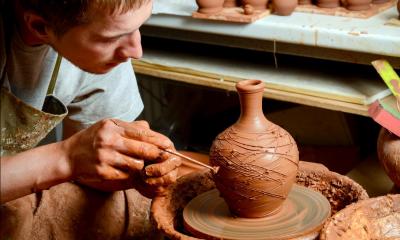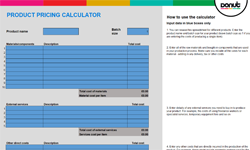
Good artistic, design and practical skills are essential if you want to set up a pottery. You'll find all you need to start up and run your own business in our practical guide.
- Research your target market
- Establish your customer profile
- Your pottery business
- Your product ranges
- Selling on ebay
- Raw material
- Making and firing pots
- Pricing policy
- Buy an existing business
Research your target market
Estimating demand
It's very important to research your market to make sure that there will be a demand for the ceramic products that you intend to make. Much will depend on the nature of the pottery business you have in mind.
Production of china and earthenware items in the UK has traditionally been concentrated around Stoke-on-Trent and the West Midlands, where large concerns such as Wedgewood and Royal Doulton - and more recently Emma Bridgewater - produce a wide range of table, kitchen and giftware for the home and export markets. There are also thousands of small potteries all over the country, some producing commercial ranges in large quantities, others firing their kilns every now and then because they produce very individual and artistic pieces.
If you are planning to sell your products in large quantities on a national basis you will need to make sure that you can compete with existing ceramic concerns as well as imported products. Consumers have turned away from traditional dinner and tea services and are looking for more informal and colourful kitchen and table ware. It may be that you have identified a niche in the market which you can fill. For example, making Mediterranean-inspired tableware for restaurants and bistros.
Establishing the level of competition
You might decide to set up a small studio, building a wood-fired kiln yourself and producing small ranges of table, kitchen and gift ware for a local market. If this is the case it would be wise to check out the competition in your area to establish:
- how many other potters there are
- what type of pots they produce and what techniques they use
- whether they sell their pots from their studios or workshops
- how much they charge for their pieces
- who are their customers
- what other goods and services - if any - they offer
Why will customers choose your pottery
You will need to make sure that enough customers will buy your pieces rather than other potters' work. Your market research might indicate that there is a gap in the market that your business can fill, for example producing souvenirs for the tourist market or accepting personalised commissions for weddings, christenings and other anniversaries. You might also consider making ranges of products specifically for local trade customers. For example, tableware for a nearby catering establishment, pots and planters for an independent garden centre, or an exclusive range of mugs, pots and bowls for sale in a local art gallery shop.
Research current trends, plus legal and tax issues
Establish your customer profile
Your customers will depend to a certain extent on the nature of your pottery business.
For example, if you plan to produce thousands of souvenir or commemorative mugs you will probably sell them to wholesalers or direct to the retailers who will sell them. It is unlikely that your workshop will be open to the public.
If you are planning to set up as a craft potter you may well encourage members of the public to come to your workshop. You will set aside an area in which you can display your ranges and take orders for any specially commissioned pieces. You may also sell to local craft centres and galleries. These customers will expect to be able to apply a 100% mark up or thereabouts so you will have to adjust the trade price of your ranges accordingly. Some may only take your products on a sale or return basis (SOR) instead of buying them from you to re-sell.
You may also sell to members of the public at craft fairs, through your website or an online marketplace, or by mail order.
You might decide to offer pottery throwing or pottery painting parties for children and adults - either in your workshop or at your customer's venue, using a mobile pottery studio.
How will customers pay
Your trade customers are likely to want a credit period of, say, one month and they will probably pay you by cheque. Members of the public may pay you in cash for small items (for example a mug or egg cup) but by cheque or debit or credit card for more expensive products or for large quantities. Do make sure that you always have a big enough 'float' so that you can give customers change if they do offer to pay in cash. If you are located in a rural area it may not be possible to pop to a nearby retailer to change a £20 note.
If you sell your products online through an e-commerce website, you might accept payments through services like PayPal and Nochex.
Discounts
You might decide to offer members of the public a discount if they buy in large quantities - for example, 12 mugs for the price of 11. However, bear in mind that your customers are attracted to your products primarily because they are individual and pleasing objects and they are probably prepared to pay the full price.
Your pottery business
Your own talents, experience and inclinations will affect the type of pottery business you decide to run. Although in practice there is a certain amount of overlap, it is likely that the main focus of your business will be one of the following:
'Production line' pottery
This type of pottery business produces large quantities of a limited range of products, for example mugs. These are usually produced as quickly and cheaply as possible, for example they are fired only once, having been dipped or sprayed with glaze. They are targeted at the 'cheap and cheerful' end of the market. If you plan to operate this type of business you would be firing your kiln frequently and producing a standardised product in large volumes.
'Commercial' pottery
This type of pottery is usually set up and run by a skilled potter who has been trained in ceramics and who is interested in producing attractive ranges for more discerning customers. If this is the type of pottery business that appeals to you it is likely that you would produce some standard ranges of kitchen, table and garden ware that you sell through craft shops and other retail outlets. You might well sell them through your own website too - or through online marketplaces like eBay, Etsy and Not On The High Street. Your pots would probably be fired more than once because you would be interested in different glazes and decorative effects. Depending on the size of your kiln you might only undertake a firing every month or so.
As well as producing your standard ranges you would probably also accept individual commissions and you might also produce one-off studio pieces from time to time. Some businesses use a mobile pottery studio to offer pottery parties at schools and private venues.
Craft potter
Craft potteries are usually small concerns set up by skilled potters who are very interested in experimenting with different clays, glazes and forms. Many build their own wood fired kilns and constantly modify their techniques to achieve different effects. Many of the pots produced are very beautiful pieces and are exhibited in art galleries and craft centres. If this is the type of pottery business that appeals to you, it is likely that you will produce a range of 'bread and butter' pots that you sell from your studio or workshop, as well as more artistic and individual pieces which may be included in exhibitions. Because it will take you some time to make enough objects to fill the kiln you might only fire a wood-fired kiln every couple of months or so.
Your product ranges
If you plan to set up a craft pottery it is likely that you will produce some or all of the following:
- mugs, plates, cups and saucers, teapots, jugs, egg cups and so on
- serving bowls, serving plates and platters
- decorative or commemorative plates
- decorative bowls, vases and pots
- ornaments and objets
- garden pots and planters
- tiles
- jewellery
These will be produced from different clays and will be decorated in different ways. For example, you might use various glazes to create the effects you want or you might hand paint the items. You might apply ceramic transfers (or decals) to your pots - these will have been printed by silk screen printers using ceramic pigments.
Whatever the nature of the pottery ranges you produce, it's essential to make sure that your potential customers know about you.
These are a number of things you can do to promote your workshop:
- produce a catalogue to distribute to businesses which might commission you to produce wares specifically for them (for example catering establishments)
- join forces with other potters and organise exhibitions
- become a member of the Craft Potters Association (CPA), which features members' work in their directory and also organises exhibitions.
- have your pottery listed in the Studio Pottery website directory
- set up your own website showing the range of wares you produce - you could also sell online if your website is e-commerce enabled. Adding Pin It buttons makes it easy for people to save and share the products featured on your website
- advertise in local directories and tourist guides
- make an attractive sign for your studio, if you plan to make retail sales from it
- exhibit regularly at local craft fairs and agricultural shows
- have 'open days' and demonstrations which you advertise by posters and leaflets
- use social media like Facebook and Twitter to tell people about your latest products and shows
- see if local cafes and restaurants will display and sell your pieces - for a commission
Word of mouth recommendations can be very valuable so whenever anyone visits your pottery make sure there is a card or leaflet that they can take away with them. If they like your work they will pass your details on and this will help to build your reputation.
Selling on ebay
Selling online can be an excellent way of reaching new customers and boosting your sales. But setting up your own ecommerce website can be expensive and you may not be sure at the beginning whether the value of the sales you'll make online will justify the set-up costs.
As an alternative, trading on eBay lets you get a feel for selling online but with much lower start up costs. And you may decide to keep on selling through eBay even when you have your own online shop.
Getting started
You might already have your own personal eBay account that you use to buy items for yourself and to sell things that you don't need any more. But if you're trading as a business on eBay you're legally obliged to make it clear in your listings that you're a business seller. This means that you'll either need to register a new business account or upgrade your personal account to a business one. There's guidance in the eBay Business Centre on the definition of 'trading' if you're not sure whether you need to register as a business seller.
If you're not already running a business and you intend to start sellingthings on eBay - perhaps just in a small way to begin with - then you'll need to notify HM Revenue & Customs (HMRC) that you're trading. There's a guide on what counts as trading and self employment which gives advice about notifying HMRC and other tax obligations on the Gov.uk website.
Decide whether to have your own virtual 'shop'
Having your own virtual storefront will give your business a valuable online presence and will allow you to display all your products together in one place.
When you sign up to sell on eBay, you have the option of setting up an eBay Shop. This allows you to create your shop using an existing template or to customise it to your own design. You don't have to choose the eBay Shop option straight away - you may decide it's best to wait until your monthly sales build up to a certain level and then upgrade.
How much does selling eBay cost?
Before you start selling on eBay it's a good idea to find out how much you'll have to pay in fees. Depending on the items you sell and the method you choose for selling them, your total fees can be quite substantial. And while some of the fees you pay will be linked to the number of items you sell each month, others are likely to be fixed costs which you incur even if you don't sell anything.
eBay gives you the option of selling as a business seller without paying any fixed monthly fees, although it's usually more cost-effective to choose a subscription-based package unless you're only selling a small number of items each month.
The eBay website has a fee illustrator tool and a fee calculator that will help you compare the fees for different selling methods and get a good idea of how much your actual per-item selling fees are likely to be.
Managing your listings
Uploading your inventory to eBay and managing your listings can be a time consuming task, particularly if you're planning to sell a large number of items.
eBay offers various listing tools designed to streamline this process, some of which are free and others that you'll have to pay for.
Promoting your items
Because there's such a huge number of items for sale on eBay at any one time, it's very important that you do everything you can to stand out from the crowd.
Always make sure that your listings include accurate, spell-checked descriptions and that your photos and other images show the items that you're selling in the best possible light.
You might want to take it a step further and use the various marketing tools provided by eBay such as search optimisation and cross-promotions.
Your reputation
As an eBay seller your online reputation is extremely important. All sellers have a feedback score based on actual customer feedback and this is the main measure that future customers will use to check that you are trustworthy and reliable.
So you'll want to keep your rating as high as possible by providing an excellent level of customer service and fast delivery at reasonable prices. Make sure you always respond promptly to customer queries, deal with returns efficiently and keep an eye on your stock levels to avoid your listings showing an item as being in stock when it has sold out.
Be aware that packing up orders and sending them out can be time consuming, but it's important to stay on top of the job to make sure that the right items get delivered in good time to the right people. Very many parcel delivery services now offer bulk shipping tools that integrate with your eBay account and these can greatly simplify the process of arranging and tracking your deliveries.
More information
The eBay website has a great deal of useful guidance to help you get started as a business seller and to expand your business as demand for your products grows. There's also a lively seller community forum where experienced sellers are often happy to answer questions.
Raw material
Ceramic products may be made from:
Bone china
Bone china is made from china stone, china clay and bone ash from cattle bones. This mixture produces fine china ware such as traditional tea services.
Hard porcelain
This is made from china clay, feldspar and quartz and when fired produces strong wares which are semi-translucent. Tea and dinner services and ornaments might be made from porcelain.
Earthenware
This is made from a mixture of china clay, ball clay, flint and china stone. Because it is not as strong as bone china and porcelain, pots made from earthenware must be thicker and so they are heavier.
Stoneware
Stoneware is earthenware with more china stone in the mixture. This makes it more expensive, although it is harder and so is often used for garden pots.
There are very many different clays available, each of which has different colours and uses. You might mix together two or more different clays in order to achieve a particular consistency. Some potters mix local clays with commercially prepared clays so that a highly individual finish and effect is obtained.
You can buy clays which are ready to use or you can buy them in powder form - when you want to use them you mix them with water.
Ceramic items are usually glazed to make them less porous and also to give them a pleasing effect. Glazes may be sprayed or brushed on or the item may be dipped. There are very many glazes available and craft potters often experiment with different materials such as ash or salt.
You can find out more about different clays and techniques on the Potterycrafts website.
Making and firing pots
Shaping the clay
The first stages of producing ceramic items involve mixing the clay and extracting any air from it in a machine known as a pugmill. The clay 'body' is now ready to be shaped into its final form. You might throw it on a potters wheel, use a mould, or, if it is to be a very big pot, you might build up the shape by coiling the clay and then smoothing it. Then you will store it on a rack to allow it to dry and become hard before firing.
Depending on the nature of your product ranges you might at this stage decorate the item - for example glazing it - and then give it just one firing to a high temperature of around 1,300°C. Or you might fire it undecorated to a lower temperature (around 900°C) - this is known as a 'bisque' or 'biscuit' firing. You then apply decoration or glaze and fire the item again to a temperature of around 1,300°C. Some potters fire the same item several times to achieve a certain effect.
The kiln
Your kiln may be fuelled by wood, gas or electricity. Wood-burning kilns give the ceramic items a very distinctive appearance. Part of the appeal of this type of pottery is the fact that the finished effect is quite unpredictable so that no two pieces are identical.
The items are loaded into the kiln on heat resistant racks which are called 'kiln furniture'.
It is important that the kiln is well packed so that items do not fall and break when the firing is over and the kiln is unloaded.
The temperature in the kiln is gradually increased until it reaches the desired temperature. It is kept at this heat for a certain length of time so that all the items are 'cooked' - this period is known as the 'soak'. Once this is over the kiln gradually cools down until it is safe to remove the fired items. Firing generally takes several hours in an electric kiln and much longer in a wood fired one.
Pricing policy
How will you decide on your prices?
Getting the price right is very important. You must make sure that the difference between the cost price and the selling price is enough to cover all of your operating costs, including your own drawings.
Although the cost of the raw materials you use is likely to be quite low, your energy costs may be high and, of course, producing pots by hand is time consuming - you will only be able to produce a certain volume each year. If this is to be your only source of income you must price your pots at a realistic level in order to generate enough income.
One of the problems for the craft potter lies in the fact that in recent years garden centres all over the country have imported attractive pots and planters in huge quantities. They are sold at low prices and this has made it difficult for potters to charge higher prices for similar size products.
If there are other, similar potteries in your area you could price your pots in line with theirs. You could approach local galleries and craft centres with examples of your work and ask them what, in their opinion, they could sell them for. Don't forget, they are likely to want a mark-up of around 100% on what they pay you.
If you're planning to sell your pieces through an online marketplace, like Etsy or Not On The High Street, you'll have to pay charges like a joining fee or a fee for listing your products. You'll also pay commission or a sales fee on each item sold. Make sure you take this into account when you set your prices.
 Free pricing calculator
Free pricing calculator
Setting the right price right is essential. Too high, and you'll struggle to make the sale. Too low and you're throwing away potential profit.
Make sure the price is right with our free product pricing calculator. Answer a few quick questions to work out what you should be charging.
Buy an existing business
You might decide to buy an existing pottery business rather than start your own venture from scratch. Buying a going concern can mean that the products, customers, regular sales, staff, premises and equipment are already in place.
But buying a business can be a hazardous, expensive process unless you have the right skills and experience on your team, including legal and financial know-how. Establish the genuine trading and financial position, so that the price you pay for the business is not too high.
If the success of the existing business depended on the individual nature of the pottery wares produced, will you be able to produce similar ranges? For example if the pottery had a reputation for decorative hand-painted pieces, do you have the training and skills to carry on producing items like this



